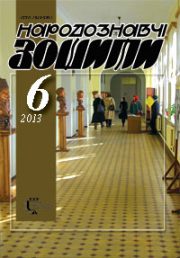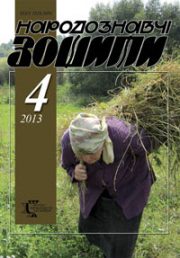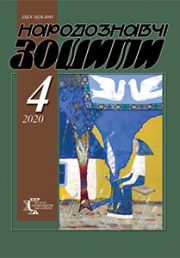The Ethnology Notebooks. 2021. № 3 (159), 563—580
UDK 746.1(477.51)
DOI https://doi.org/10.15407/nz2021.03.563
TRADITIONAL WEAVING OF THE INHABITANTS OF THE NORTH-EASTERN PART OF CHERNIHIV REGION
TELEHEY Nataliia
- ORCID 0000-0002-4558-9045
- State Scientific Center for Protection
- of Cultural Heritage
- from Man-Made Disasters,
- Researcher of the Department of Ethnology,
- Victory Avenue, 56, Kyiv, 03057
- Contacts: e-mail: natalija.veselyna@gmail.com
Abstract. At the present stage of social and technological development, home-made fabrics exist only as an element of artistic and reconstruction use. In this context, the topical issues are regional and local features and territorial differentiation of traditional weaving as a set of technological processes for fabric production, as well as related rituals and beliefs, which is what led to the relevance of this article.
The purpose of the study is a comprehensive review of the tradition of home weaving as an element of culture and life of the inhabitants of Chernihiv region.
The subject of the research is the characteristic traditional weaving of Semenivskiy and Novhorod-Siverskyi districts, its general regional and local features and territorial differentiation, as well as transformational processes in fabric decoration in the second half of the XX century — at the beginning of the XXI century. In particular, the following were studied: cultivation of fibrous plants (flax, hemp); the process of processing the stems, which included: soaking, drying, shaking, crumpling and combing flax or hemp; rubbing of yarn; spinning yarn on a comb or spinning wheel; warping; refueling of a loom; finishing of textile products with woven or embroidered patterns; rituals and beliefs that accompanied the process of creating cloth; use of fiber, thread and cloth in everyday life and rituals.
The article is based on the author’s field materials collected during the work of a comprehensive expedition of the State Scientific Center for Protection of Cultural Heritage from Man-Made Disasters in 2019 from people living in the Semenivskyi and Novgorod-Siverskyi districts. Field information was collected by oral questioning. The interviewees were mostly women who were born and lived permanently or for a long time in one locality.
Keywords: Weaving, Polissia, Semenivskyi district, loom, weaving weaves, yarn, cloth, flax.
Received 4.06.2021
REFERENCES
- Dudar, O. T. (1979). Artistic weaving of Polissya. Folk arts and crafts of Ukraine. Collection of scientific works (pp. 69–78). Kyiv: Naukova Dumka [in Ukrainian].
- Nykorak, O. (2004). Ukrainian folk fabric of the XIX-XX centuries: Typology, localization, artistic features (T. 1). Lviv [in Ukrainian].
- Zakharchuk-Chugai, R. (2007). Folk decorative art of Ukrainian Polissya. Chernobyl. Lviv [in Ukrainian].
- Selivachov, M. (2005). Lexicon of Ukrainian ornamentation (iconography, nomination, stylistics, typology). Kyiv [in Ukrainian].
- Lashchuk, Yu. (1992). Folk art of Ukrainian Polissya. Lviv: Kamenyar [in Ukrainian].
- Orel, L. (2003). Ukrainian towel (historical and cultural research). Lviv [in Ukrainian].
- Boryak, O. O. (1997). Weaving in the rites and beliefs of Ukrainians (mid-nineteenth — early twentieth century). Kyiv [in Ukrainian].
- Bondarchik, V. K., Kyrchiv, R. F. (Eds.) (1988). Polesie. Material culture. Kiev: Naukova Dumka [in Russian].







